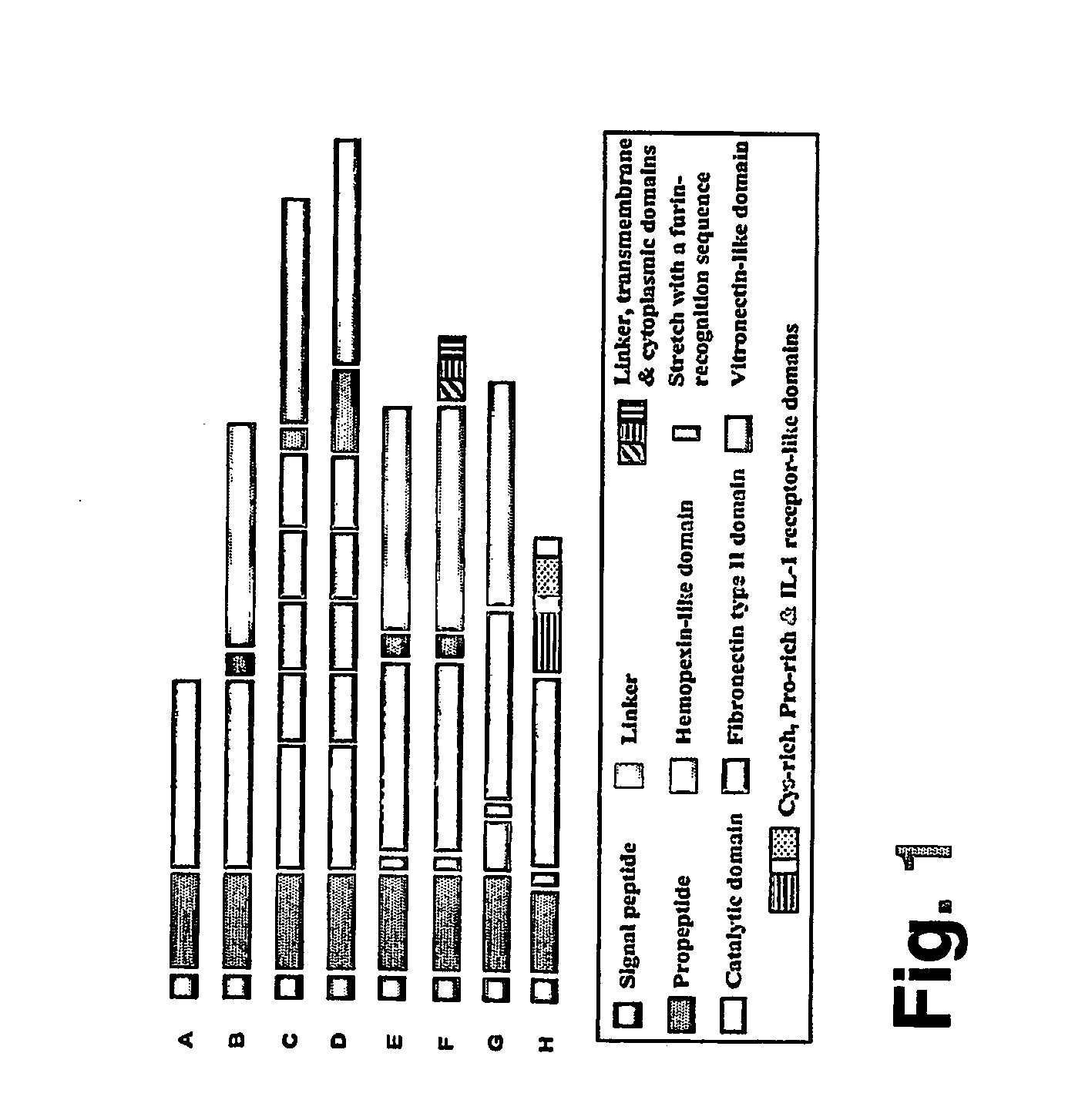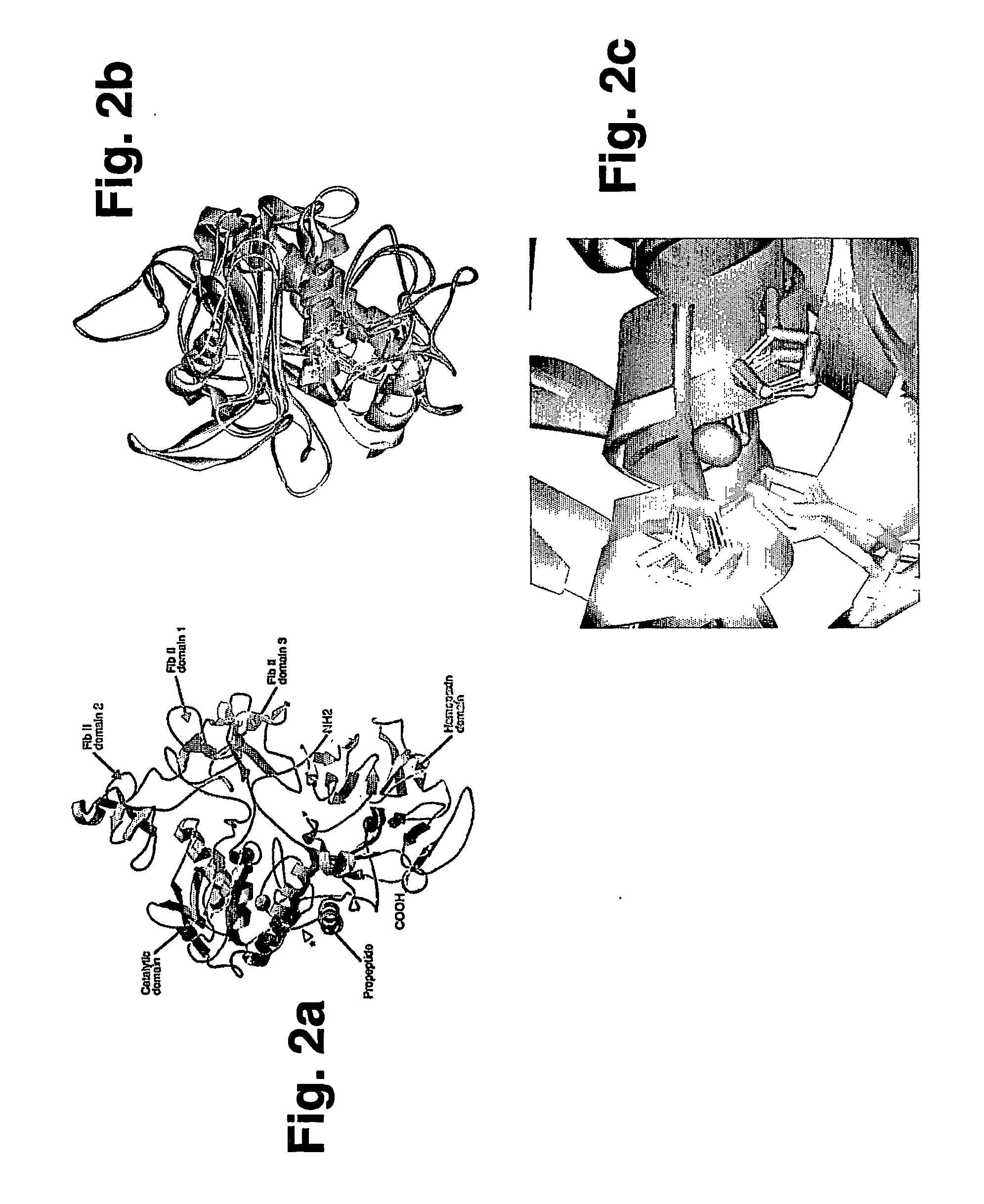Antibodies and pharmaceutical compositions containing same useful for inhibiting activity of metalloproteins
a technology of metalloproteins and antibodies, which is applied in the direction of antibody medical ingredients, drug compositions, peptides, etc., can solve the problems of uncontrolled breakdown of connective tissue by metalloproteases, peptide-based mmp inhibitors have clear therapeutic potential, and limited clinical use of peptide-based hydroxamate,
- Summary
- Abstract
- Description
- Claims
- Application Information
AI Technical Summary
Benefits of technology
Problems solved by technology
Method used
Image
Examples
example 1
Preparation of Monoclonal Antibodies Against the MMP-2 Active Site
[0169] For the production of a specific monoclonal antibody against the electronic and physical features of the MMP-2 active site synthetic haptens (FIG. 3) with an analogue structure to the MMP-2 active site, ie., a zinc ion coordinated to three histidines and a water molecule (Kleifeld et al., 2001), were synthesized and further used for mice immunization.
[0170] Material and Experimental Methods
[0171] Synthesis of Co-TCPP and Zn-TCPP haptens—The tetra-carboxy phenyl porphyrin Co(II) (Co-TCPP) and the tetra-carboxy phenyl porphyrin Zn(H1) (Zn-TCPP) haptens were synthesized as follows: 63 mM of either Co(OAc)2·4H20 or Zn(OAc)2·2H20 in a solution containing methanol and acetic acid at equal concentrations were added to 6.3 mM TCPP. The mixtures were heated for 30 min at 60° C. during which the organic solvents evaporated. The residues were dissolved in the same methanol / acetic acid solution and purified using a sili...
example 2
Identification and Calssification of Monoclonal Antibodies
[0180] Mononclonal antibodies were identified and classified by their affinity and competition to conjugated haptens.
[0181] Materials and Experimental Methods
[0182] Affinity of the monoclonal antibody to conjugated haptens—Microtiter plates (Maxi Irmmunoabsorp, Nunc, Rehovot, Israel) were coated for 1 hour with 3 μg / ml of Hapten conjugates in PBS, blocked for 1 hour in 1% BSA / PBS and further subjected to 1 hour incubation with various concentrations of monoclonal antibodies. Coated plates were then washed three times in 0.04% Tween-20 (Sigma, rehovot, Israel) in PBS followed by 1 hour incubation with a secondary goat anti mouse perocidase conjugated antibody (Jackson ImmunoResearch Laboratories Inc., Tel-Aviv, Israel). Plates were then washed again in PBS and peroxidase reactions were developed in a solution containing 0.028 M citric acid , 0.044 M Na2HPO4, 1 mg / ml ABTS (2,2, azino-bis(3-Ethylbentiazoline-6-sulfonic acid) ...
example 3
Charcterization of MMP-2 Monoclonal Antibody
[0188] To further characterize the Co-TCPP monoclonal antibody competitive assays with hapten competitors and immuno-precipitation assays were performed.
[0189] Materials and Experirneimtal Methods
[0190] Competitive assay—Monoclonal antibodies (at 50% binding concentration) were incubated for 1 hour with the TCPP, Co-TCPP, Zn-TCPP, Zn-TPP hapten competitors and were then transferred to hapten-coated microtiter plates as described in Example 2 hereinabove. The dissociation constant required to attain 50% binding was determined.
[0191] Immuno-precipitation—Protein A beads Pharmacia, Rehovot, Israel were washed in PBS according to manufacturer instructions. Ten μg of monoclonal antibody in 300 μl PBS were added to ˜30 μl of washed protein A beads and incubated over night at 4° C. Protein A-bound antibodies were then washed three times in PBS and further incubated for 3 hours at RT with 1 μg of MMP-2 catalytic domain [Megapharm (Oncogene Res...
PUM
| Property | Measurement | Unit |
|---|---|---|
| temperature | aaaaa | aaaaa |
| pH | aaaaa | aaaaa |
| concentration | aaaaa | aaaaa |
Abstract
Description
Claims
Application Information
 Login to View More
Login to View More - R&D
- Intellectual Property
- Life Sciences
- Materials
- Tech Scout
- Unparalleled Data Quality
- Higher Quality Content
- 60% Fewer Hallucinations
Browse by: Latest US Patents, China's latest patents, Technical Efficacy Thesaurus, Application Domain, Technology Topic, Popular Technical Reports.
© 2025 PatSnap. All rights reserved.Legal|Privacy policy|Modern Slavery Act Transparency Statement|Sitemap|About US| Contact US: help@patsnap.com



